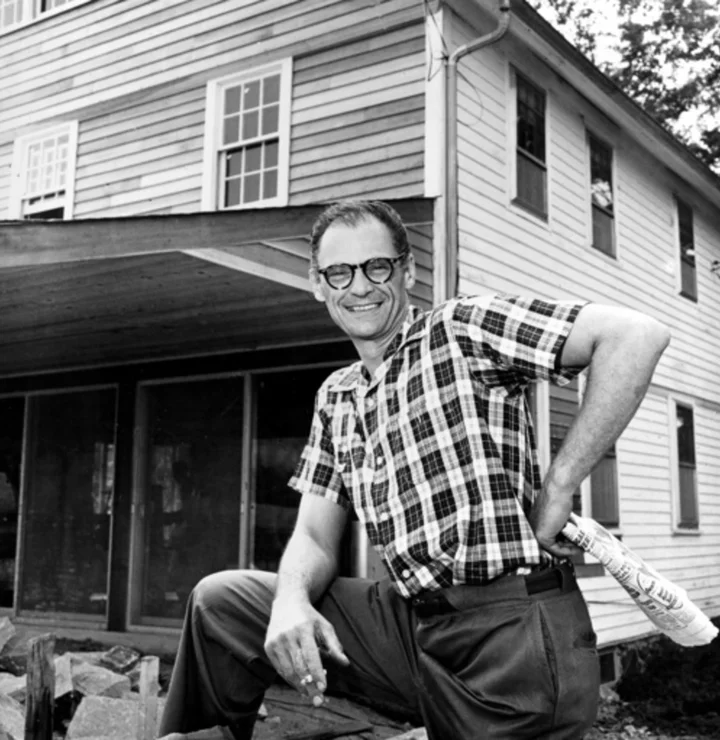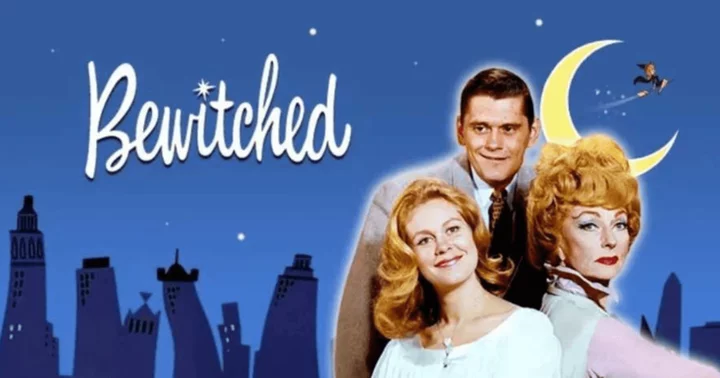ROXBURY, Conn. (AP) — After breakfast each morning, renowned playwright Arthur Miller would walk up a grassy slope to his creative sanctuary, a modest 300-square-foot studio with a small deck overlooking a stream and woods on his beloved Connecticut property.
From 1958 until his death in 2005 at age 89, it was where the Pulitzer Prize-winning writer crafted and revised numerous plays, social commentary, personal journals, his autobiography and other materials, including screenplays for the films “The Misfits” (1961) and “The Crucible” (1996). Considered one of nation's greatest playwrights, Miller was known for his dramas with strong moral and personal responsibility that often laid bare the failings of the American dream.
Today, the view from the studio is less inspiring.
Unbeknownst to many locals, for the last five years, the shingled, one-room structure has been tucked away behind the Roxbury, Connecticut, town hall — next to a rusted dumpster and snow plows in a nondescript parking lot, awaiting an uncertain next act.
“It’s a piece of Roxbury history. And we can’t let it disappear,” said Marc Olivieri, a former neighbor of Miller’s and a builder who moved the studio to its current location, which was supposed to be temporary.
A group working with Miller's daughter, writer and filmmaker Rebecca Miller, has been trying to raise $1 million to renovate the structure and move it to the grounds of a local public library.
They also hope to offer related programming, which Olivieri, a board member for the nonprofit Arthur Miller Writing Studio, insists is the most important part of the project.
“Ideas and ideals are essential to maintaining the moral direction of this country," Olivieri wrote in an email. "Writers like Miller provide the stories that color these ideas.”
Roxbury is a quiet, bucolic community of 2,200 that is about 87 miles (140 km) northeast of New York City, and has long been a home to famous writers, artists and performers — including the late Broadway lyricist and composer Stephen Sondheim, the late authors Frank McCourt and William Styron and the late sculptor Alexander Calder.
In the late 1950s, Hollywood legend Marilyn Monroe, Miller's second wife, lived there too.
“A lot of these people go there because it’s not New York. It’s out of the way. It’s quiet and people don’t make a fuss about them," said Sarah Griswold, board president of the Arthur Miller Writing Studio. “There's no real commemoration or acknowledgment of the creativity that lives in these hills.”
The group, which is partnering with other Arthur Miller organizations, hopes future visitors to the studio will learn about the playwright's work and activism, as well as attend workshops on writing, theater and topics he cared about, such as mass incarceration. There are plans to eventually host writer residencies and an online repository.
But the group has so far raised less than $20,000 through its GoFundMe site and is now under pressure to step up fundraising efforts due to planned improvements to the highway department's parking lot.
The studio, which Miller helped design and which still has the mismatched, linoleum floor tiles he laid himself, was the playwright's second writing spot in Roxbury. He wrote “Death of a Salesman” (1949) at a cabin he built at a previous home.
The newer studio wound up in its current spot after Rebecca Miller sold her father's second property. Figuring the new owners might tear down the small outbuilding, she turned to the town for help and paid to have it shored up and moved temporarily.
Rebecca Miller, who said she set aside proceeds from the house sale to contribute toward the $1 million goal, is donating the studio to the town.
“It could go all sorts of places, but I really wanted it to belong to Roxbury because Roxbury was really his home for such a long time," she said. “And so I thought it was kind of beautiful that it would belong to the town ultimately.”
But fundraising has been challenging.
“You can have a poetic idea, but then to actually make this happen is another thing entirely," she said.
“I do feel that there is money in the community,” she said. “Once people realize that others are giving, I think there will be more of a sense of people giving. And I think there is starting to be a groundswell of support.”
Rebecca Miller salvaged the modest furnishings from the studio, including a daybed, a pot-belly wood stove and an old metal office chair that her father, a jack-of-all-trades, insisted on fixing rather than replacing. Once the building is renovated, the items will be arranged just like the playwright left them.
Black-and-white photographs taken by Magnum photographer Inge Morath — Rebecca Miller's mother and Arthur Miller's third wife — document the playwright at work over the decades in the 14-by-20-foot space. The images will be used as a guide.
Arthur Miller progressed from working at a desk he made from a wooden door to eventually a third desk he built with heavy plywood to hold his early computer equipment and a printer.
Wearing his signature dark-rimmed glasses, he's seen in a 1997 photo sitting back and reading over a manuscript, surrounded by dark wood paneling. Nearby, there's an open dictionary and a typewriter. A radio and reference books sit on some shelves.
In another photo, taken 25 years earlier, a serious-looking Miller poses, crossed legs, with a pipe in his mouth. A photo from 1963 shows him meeting in the studio with director Elia Kazan and producer Robert Whitehead, who worked together on the play “After the Fall,” which ran on Broadway for 208 performances.
The writer's literary assistant in the last decade of his life, Julia Bolus — also director of the Arthur Miller Trust and a Writing Studio board member — remembers the studio well. She said they worked there together in the afternoons after Miller was done writing for the day.
“For almost half a century, it was his central space and his one private space,” said Bolus, who is working on a project to publish Miller's journals. “The door was always open to his family, but people did give him ... that morning time to himself.”
Mary Tyrrell, a pharmacist and owner of the historic Canfield Corner Pharmacy in nearby Woodbury, remembers how Miller would pick up his newspaper and chat at the soda fountain with her late mother, Vera Elsenboss, the former owner. Tyrrell described the writer as unassuming — someone who might be a little embarrassed by today's public attention to his no-frills literary refuge but who would ultimately appreciate it being preserved.
One day, Tyrrell said, her mother demanded the writer take off his favorite sweater and allow her to mend the worn-out elbows with new leather patches. Miller lamented that it wasn't the same.
“She goes, ‘You’re right, Arthur, but this is what you deserve,’” Tyrrell said. “The people who loved him revered him as more than he thought of himself sometimes, which is kind of a nice thing for the community.”









